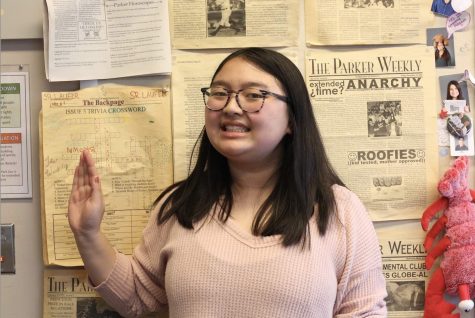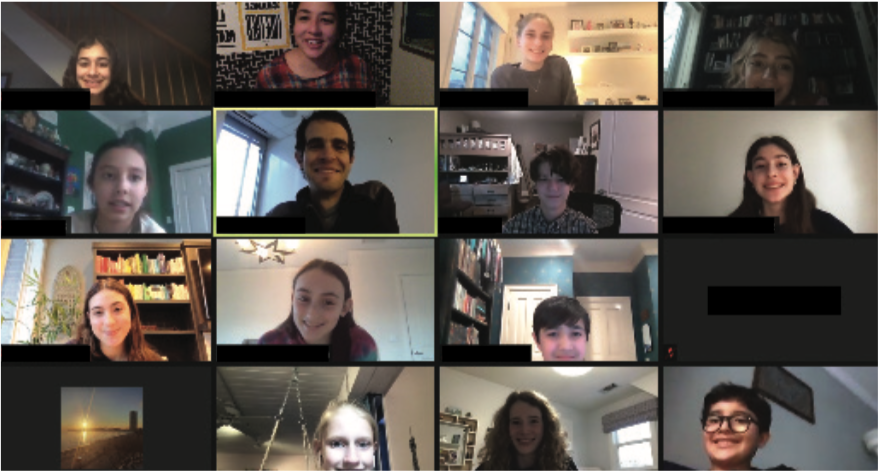What’s Up With Middle School?
Middle School Clubs and Affinity Groups Continue to Meet on Zoom
Photo credit: Stephanie Nishimoto-Lorenzo
Middle School Model UN meeting over Zoom.
After coming home from school, Middle Schoolers open Google Classroom and access Zoom links. They see their friends and teachers once again, but this time, it is for club meetings. While classes are in person, clubs, ally, and affinity groups have all been required to become virtual. Almost every Middle School club – 12 during the fall – have moved to an online format and meets after school.
Since students are assigned pods for contact tracing of COVID-19, the clubs meet virtually in order to reduce any transmission of the coronavirus. Students have an hour after school ends before clubs start for them to commute home. Those who are unable to get home are able to stay after school.
There are three slots every afternoon for club meetings that are 30 or 45 minutes long. Faculty sponsors choose a time slot and Intermediate and Middle School Dean of Student Life Tray White creates the schedule every eight weeks. “My hope is that maybe at the end of this eight weeks COVID will go away,” White said.
Students access links for the clubs and schedules through Google Classroom. The weekly schedules are posted under the classwork section and each schedule document has the time and link for the clubs.
“We’ve had to be really creative with how we transition activities whether it’s clubs or an affinity or an ally group,” White said. “How do you transfer a really intense conversation or processing spaces and celebratory spaces about identity? How do you do that in a confidential way, in a way that brings community on zoom? Not to have a physical presence is a definite loss, but we found other ways to keep community, to foster that, to cultivate that.”
The only club that was not able to move online was Board and Card Games Club. Seventh Grade Math Teacher and Board and Card Games Club faculty sponsor Chris Stader hopes to have the group start again. “The biggest challenge is just with moving to a virtual space with physical games and having a much more limited selection of games that are available to play,” Stader said.
Middle School Model UN has continued to meet and do symposiums online. Usually, Middle School Model UN would meet on Wednesdays at 3:30 but now they meet each Wednesday at 4:00 to 4:45. According to Eighth Grade history teacher Stephanie Nishimoto-Lorenzo, the format of Middle School Model UN has not changed very much. The delegates are continuing to work on a three week rotation of introducing and researching a topic, working on additional research and skills, and a symposium. The main change is that since club meetings are shorter, symposiums take more than one session.
Nishimoto-Lorenzo also is the faculty sponsor for Asian/Asian American Affinity Alliance. While in person, the affinity group would meet during lunch and share food but now they meet after school. Asian/Asian American Affinity Alliance serves as a space for students who identify as Asian or Asian American to come together. Though there are less students attending the affinity group, they meet more often than in person since they meet after school rather than during a lunch rotation.
Nishimoto-Lorenzo believes that it has created a more intimate group. “We get to meet more frequently for Asian Affinity which is really, really good for building stronger relationships so maybe that’s the silver lining,” Nishimoto-Lorenzo said. “I’m glad that we can still meet versus not not getting to meet.”
Middle School robotics was not able to attend their FIRST LEGO League due to the coronavirus but continued meeting and creating robots virtually. Rather than creating physical robots, they used Virtual Robotics Toolkit, a platform which simulates robots and tools virtually. “The program was nice because all the students could build and code their own robot simultaneously,” Lab Technician and faculty sponsor John Navin said. “We did not misplace one LEGO piece this season.”
According to Navin, the program had issues where it ran slowly and he thought that both the coaches and students did not like the software. “Working with the program created more problems than working with the LEGO robots in person,” Navin said. He hopes that the team will be able to compete in the FIRST LEGO League next season.
La Mesa Hispana is an affinity and ally group where students learn about Hispanic culture by talking about a topic, making crafts, interviewing people from a certain country, and eating food reflecting the topic they are learning about. Before the pandemic, the club made food, ordered it, or Chef Zac provided food.
During the first meeting of La Mesa Hispana this year, they discussed street food and their favorite recipes. “We were like ‘hey, let’s start cooking. We’re in our homes, we have kitchens,’” Eighth Grade Spanish Teacher and Faculty Cosponsor Marcie Frasz said.
The faculty sponsors prepare a list of ingredients for each meeting and send out a Google Form with the list. If students sign up, they are able to pick up the ingredients while at school. “Being able to stand up at your kitchen and actually make something and do something and then eat it is very satisfying,” Frasz said.
Frasz believes that holding the club at home is better for cooking. “It’s just so hard because we’re not set up for cooking in our classrooms, like the best thing you can make is pancakes and waffles and that’s about it,” Frasz said. “So I think we’re really appreciating the opportunity to make use of our houses.”
Despite many changes due to moving clubs online, clubs have adjusted and created new ways to hold club meetings. “There’s been a discovery of this thing that we hold dear, that we thought that we were grieving, that we couldn’t do in the same way,” White said. “We discovered that you absolutely can have intimacy and have community virtually.”








